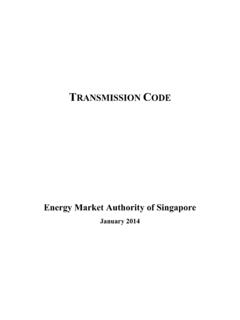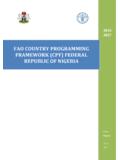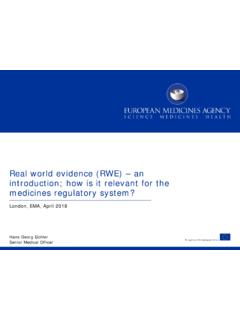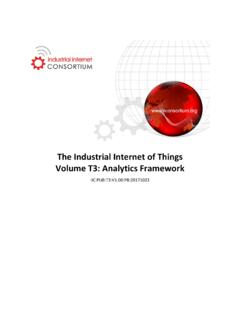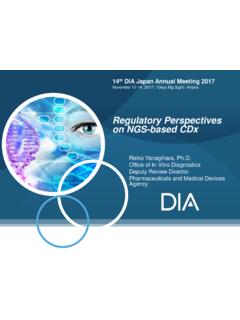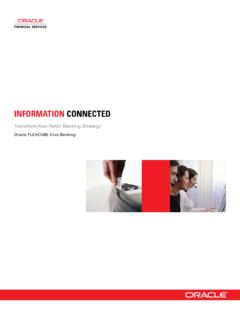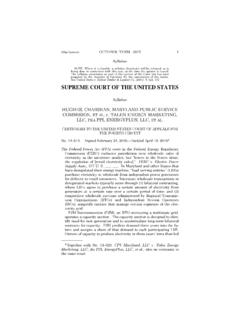Transcription of ENHANCEMENTS TO THE REGULATORY FRAMEWORK FOR …
1 ENHANCEMENTS TO THE REGULATORY FRAMEWORK FOR INTERMITTENT generation SOURCES IN THE NATIONAL ELECTRICITY MARKET OF SINGAPORE CONSULTATION PAPER 30 May 2017 ENERGY MARKET AUTHORITY 991G ALEXANDRA ROAD #01-29 SINGAPORE 119975 Disclaimer: The information in this document is subject to change and shall not be treated as constituting any advice to any person. It does not in any way bind the Energy Market Authority to grant any approval or official permission for any matter, including but not limited to the grant of any exemption or to the terms of any exemption. The Energy Market Authority reserves the right to change its policies and/or to amend any information in this document without prior notice. Persons who may be in doubt about how the information in this document may affect them or their commercial activities are advised to seek independent legal advice or any other professional advice as they may deem appropriate.
2 The Energy Market Authority shall not be responsible or liable for any consequences (financial or otherwise) or any damage or loss suffered, directly or indirectly, by any person resulting or arising from the use of or reliance on any information in this document. TABLE OF CONTENT 1 Background .. 4 2 Regulation Reserves Charges to be Allocated on a Net Basis for Contestable Residential Consumers with Embedded IGS under Full Retail Competition .. 5 3 Streamlined Arrangements for Market Registration .. 8 4 Next 10 4 ENHANCEMENTS TO THE REGULATORY FRAMEWORK FOR INTERMITTENT generation SOURCES IN THE NATIONAL ELECTRICITY MARKET OF SINGAPORE 1 Background An Intermittent generation Source ( IGS ) is defined as any source of energy that is non-dispatchable in the National Electricity Market of Singapore ( NEMS ) because the power output cannot be controlled or varied at will. Examples of IGS include renewable sources of energy such as solar energy and wind energy.
3 As of Q1 2017, there were 1,898 solar installations in Singapore with a total capacity of MWac. As the cost of solar energy continues to decrease with improvements in technology, we are anticipating more solar deployments by consumers, including residential consumers. In view of new developments in the electricity market, in particular Full Retail Competition ( FRC ) where all electricity consumers can choose an electricity retailer, as well as the evolving business models related to solar deployments, the Energy Market Authority ( EMA ) is proposing two ENHANCEMENTS to streamline REGULATORY requirements and lower barriers of entry for solar. 5 2 Regulation Reserves Charges to be Allocated on a Net Basis for Contestable Residential Consumers with Embedded IGS under Full Retail Competition Current regulation reserves cost allocation FRAMEWORK in NEMS Generating units participating in the NEMS are required to pay reserves charges.
4 Reserves, or back-up capacity, are required to ensure the reliable supply of electricity to consumers and the secure operation of the power system. Regulation reserves refer to the amount of generation capacity needed to balance the minute-to-minute variations in actual load compared to the forecasted load, and small variations in output of generating units. The cost of regulation reserves is recovered from all loads and up to 5 MWh of output by generating units in each half hourly period through the Allocated Regulation Price ( AFP ). The AFP is typically a relatively small component, amounting to about of the electricity bill for consumers. AFP allocation for consumers with embedded IGS Currently, non-contestable consumers ( NCCs ) and contestable consumers ( CCs ) with embedded IGS are subject to different AFP charge treatment (see Table 1). Table 1: Existing arrangements on the charging of AFP for consumers with embedded IGS NCCs2 CCs3 Less than 1 MWac AFP is charged on a net basis (consumption less generation ) For example, a consumer who consumes 10 units of electricity and generates 2 units of electricity, 8 units of electricity would be subject to the AFP charge.
5 AFP is charged on a gross basis (consumption and first 5 MWh of generation , for every half-hourly period) For example, a consumer who consumes 10 units of electricity and generates 2 units of electricity, 12 units of electricity would be subject to the AFP charge. 1 MWac and above AFP is charged on a gross basis (consumption and first 5 MWh of generation ) 1 This is based on the average AFP over the average retail price, from October 2015 to September 2016. 2 NCC refers to non-residential consumers ( Town Councils, Businesses) and residential consumers who buy electricity from SP Services ( SPS ) at the regulated tariff. 3 Today, only non-residential consumers with a monthly consumption of more than 2 MWh are eligible to be contestable. 6 CCs with embedded IGS are levied AFP on a gross basis. Under such an arrangement, two meters would be required for a consumer, one at the generation facility and another at the load facility.
6 For NCCs with embedded IGS below 1 MWac, we had adopted a simplified treatment4 which requires only one meter at the connection with the grid (which measures the net withdrawal of energy by the consumer), and hence the net AFP treatment for this group. The advantage of this simplified treatment is the lower cost of implementation (as only one meter is needed). The EMA has assessed this treatment to commensurate with the size of the installations, given that the solar installations deployed by NCCs are typically much smaller compared to those deployed by CCs. Refinement in AFP allocation for contestable residential consumers with embedded IGS Given the implementation of FRC in 2H 2018 where residential consumers can choose to be contestable, the EMA intends to allow net AFP treatment for all residential consumers with embedded IGS below 1 MWac, regardless of their contestability status.
7 In the event that residential consumers have embedded IGS that crosses the 1 MWac threshold (regardless of their contestability status), they would be charged AFP on a gross basis as per other consumers with large embedded IGS. Based on existing technology, the EMA has assessed that the solar installations by residential consumers tend to be small due to the limited roof space available5. For non-residential consumers with embedded IGS who choose to be contestable, they will continue to pay AFP based on the gross basis, as per the existing FRAMEWORK . This is on the basis that they are in a better position to manage the commercial risks of their investments, including the fluctuation of prices (and AFP charge) through their retailers. Table 2 summarises the proposed AFP charging regime for consumers with embedded IGS. 4 This refers to the Simplified Credit Treatment for low-tension NCCs with embedded IGS less than 1 MWac.
8 5 There are no residential consumers who have solar installations greater than 1 MWac currently. 7 Table 2: Proposed arrangements on the charging of AFP for consumers with embedded IGS NCCs CCs Less than 1 MWac AFP is charged on a net basis (No change) Residential AFP to be charged on a net basis (Proposed change come FRC implementation in 2H2018) Non-residential AFP is charged on a gross basis (No change) 1 MWac and above Residential and Non-residential AFP is charged on a gross basis (No change) 8 3 Streamlined Arrangements for Market Registration The current REGULATORY FRAMEWORK requires generating units of 1 MW and above to undergo market registration. This includes Market Participant ( MP ) and generation Facility ( GF ) registration. Mandatory market participation ensures that larger generating units are subject to the Market Rules, including ensuring that they comply with the relevant technical requirements and also pay for their fair share of charges, AFP charge.
9 As a MP, the generating unit would need to meet requirements such as installing the meters to measure the amount of energy produced for the purpose of allocating these charges, even if the energy produced is self-consumed. The industry has given feedback that the market registration process can be further streamlined. For example, instead of requiring consumers with embedded IGS to install meters for the purpose of paying market related charges, an estimated fixed sum per MW of IGS installed capacity per month can be charged. This fixed charge may be determined based on factors that include the estimated IGS generation (based on the IGS generation Profile determined by the EMA6), and the historical average rates of the respective charges. This fixed charge may be revised periodically to reflect updated market conditions. The Energy Market Company ( EMC ) would then return the amount collected to the market via the Hourly Energy Uplift Charge ( HEUC ).
10 As such, the EMA is proposing for consumers with embedded IGS below 10 MWac who will not be selling any electricity back to the market7, to undergo a streamlined market registration and requirements, including paying EMC an estimated fixed charge determined by the EMA (see Tables 3 and 4). 6 Refer to Addendum to ENHANCEMENTS to the REGULATORY FRAMEWORK for Intermittent generation Sources in the National Electricity Market of Singapore dated 9 Dec 2015 for more information: 7 Based on the size of the IGS installation, the MP will still be required to apply for the relevant licence from the EMA, where applicable. 9 Table 3: Proposed streamlined requirements for MP and GF registration Proposed requirements to be omitted for MP registration Requirements to be omitted 1 MP-MSSL Agreement Not applicable for MP with generation facilities.






